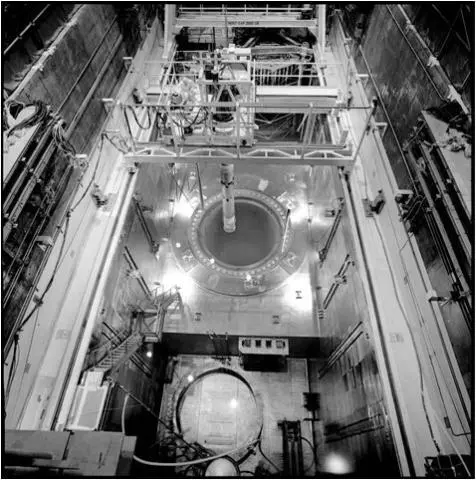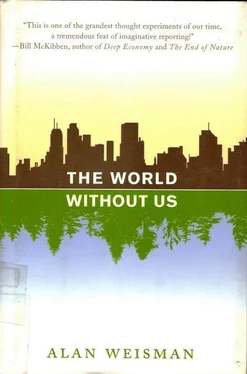Atop them, a mix of native bluestem tall grass and side-oats grama grass has been planted to assure a habitat for resident elk, mink, mountain lion, and the threatened Prebel’s meadow jumping mouse, which have impressively thrived in the plant’s 6,000-acre security buffer despite the evil brewing at its center. Regardless of the grim business that went on here, these animals seem to be doing fine. However, while there are plans to monitor the human wildlife managers for radiation intake, a refuge official admits doing no genetic tests on the wildlife itself.
“We’re looking at human hazards, not damage to species. Acceptable dose levels are based on 30-year career exposures. Most animals don’t live that long.”
Maybe not. But their genes do.
Anything at Rocky Flats too hard or too hot to move was covered with concrete and 20 feet of fill, and will remain off-limits to hikers in the wildlife preserve, though how they’ll be deterred hasn’t been decided. At WIPP, where much of Rocky Flats ended up, the U.S. Department of Energy is legally required to dissuade anyone from coming too close for the next 10,000 years. After discussing the fact that human languages mutate so fast that they’re almost unrecognizable after 500 or 600 years, it was decided to post warnings in seven of them anyway, plus pictures. These will be incised on 25-foot-high, 20-ton granite monuments and repeated on nine-inch disks of fired clay and aluminum oxide, randomly buried throughout the site. More-detailed information about the hazards below will go on the walls of three identical rooms, two of them also buried. The whole thing will be surrounded by a 33-foot-tall earthen berm a half-mile square, embedded with magnets and radar reflectors to give every possible signal to the future that something lurks below.
Whether who-or-whatever finds it someday can actually read, or heed, danger in those messages may be moot: the construction of this complex scarecrow to posterity isn’t scheduled until decades from now, after WIPP is full. Also, after just five years, plutonium-239 was already noticed leaking from WIPP’s exhaust shaft. Among the unpredictables is how all the irradiated plastic, cellulose, and radionuclides below will react as brine percolates through the salt formations, and as radioactive decay adds heat. For that reason, no radioactive liquids are allowed lest they volatilize, but many interred bottles and cans contain contaminated residues that will evaporate as temperatures rise. Head space is being left for buildup of hydrogen and methane, but whether it’s enough, and whether WIPP’s exhaust vent will function or clog, is the future’s mystery.
At the biggest U.S. nuclear plant, the 3.8-billion-watt Palo Verde Nuclear Generating Station in the desert west of Phoenix, water heated by a controlled atomic reaction turns to steam, which spins the three largest turbines General Electric ever manufactured. Most reactors worldwide function similarly; like Enrico Fermi’s original atomic pile, all nuke plants use moveable, neutron-sopping cadmium rods to dampen or intensify the action.
In Palo Verde’s three separate reactors, these dampers are interspersed among nearly 170,000 pencil-thin, 14-foot zirconium-alloy hollow rods stuffed end to end with uranium pellets that each contain as much power as a ton of coal. The rods are bunched into hundreds of assemblies; water flowing among them keeps things cool, and, as it vaporizes, it propels the steam turbines.
Together, the nearly cubical reactor cores, which sit in 45-foot-deep pools of turquoise water, weigh more than 500 tons. Each year, about 30 tons of their fuel is exhausted. Still packed inside the zirconium rods, this nuclear waste is removed by cranes to a flat-roofed building outside the containment dome, where it is submerged in a temporary holding pond that resembles a giant swimming pool, also 45 feet deep.
Since Palo Verde opened in 1986, its used fuel has been accumulating, because there’s nowhere else to take it. In plants everywhere, spent fuel ponds have been re-racked to squeeze in thousands of more fuel assemblies. Together, the world’s 441 functioning nuclear plants annually produce almost 13,000 tons of high-level nuclear scrap. In the United States, most plants have no more pool space, so until there’s a permanent burial ground, waste-fuel rods are now mummified in “dry casks”—steel canisters clad in concrete from which the air and moisture have been sucked. At Palo Verde, where they’ve been used since 2002, these are stored vertically, and resemble giant thermos bottles.
Every country has plans to permanently entomb the stuff. Every country also has citizens terrified of events like earthquakes that could unseal buried waste, and of the chance that some truck carrying it will have a wreck or be hijacked en route to the landfill.
In the meantime, used nuclear fuel, some of it decades old, languishes in holding tanks. Oddly, it is up to a million times more radioactive than when it was fresh. While in the reactor, it began mutating into elements heavier than enriched uranium, such as isotopes of plutonium and americium. That process continues in the waste dumps, where used hot rods exchange neutrons and expel alpha and beta particles, gamma rays, and heat.
If humans suddenly departed, before long the water in the cooling ponds would boil and evaporate away—rather quickly in the Arizona desert. As the used fuel in the storage racks is exposed to air, its heat would ignite the cladding of the fuel rods, and radioactive fire would break out. At Palo Verde, like other reactors, the spent-fuels building was intended to be temporary, not a tomb, and its masonry roof is more similar to a big-box discount store’s than to the reactor’s pre-stressed containment dome. Such a roof wouldn’t last long with a radioactive fire cooking below it, and much contamination would escape. But that wouldn’t be the biggest problem.

Reloading nuclear fuel: Unit 3, Palo Verde Nuclear Generating Station.
PHOTO BY TOM TINGLE, ARIZONA REPUBLIC, 12/29/98.
(USED WITH PERMISSION. PERMISSION DOES NOT IMPLY ENDORSEMENT.) {1} 1 An original illustration is missing.
Resembling giant enoki mushrooms, Palo Verde’s great steam columns rise a mile over the desert creosote flats, each consisting of 15,000 gallons of water evaporated per minute to cool Palo Verde’s three fission reactors. (As Palo Verde is the only U.S. plant not on a river, bay, or seacoast, the water is recycled Phoenix effluent.) With 2,000 employees to keep pumps from sticking, gaskets from leaking, and filters back-washed, the plant is a town big enough to have its own police and fire departments.
Suppose its inhabitants had to evacuate. Suppose they had enough advance warning to shut down by jamming all the moderating rods into each reactor core to stop the reaction and cease generating electricity. Once Palo Verde was unmanned, its connection to the power grid would automatically be cut. Emergency generators with a seven-day diesel supply would kick in to keep coolant water circulating, because even if fission in the core stopped, uranium would continue to decay, generating about 7 percent as much heat as an active reactor. That heat would be enough to keep pressurizing the cooling water looping through the reactor core. At times, a relief valve would open to release overheating water, then close again when the pressure dropped. But the heat and pressure would build again, and the relief valve would have to repeat its cycle.
At some point, it becomes a question of whether the water supply is depleted, a valve sticks, or the diesel pumps cut out first. In any case, cooling water will cease being replenished. Meanwhile, the uranium fuel, which takes 704 million years to lose just half its radioactivity, is still hot. It keeps boiling off the 45 feet of water in which it sits. In a few weeks at the most, the top of the reactor core will be exposed, and the meltdown will begin.
Читать дальше












